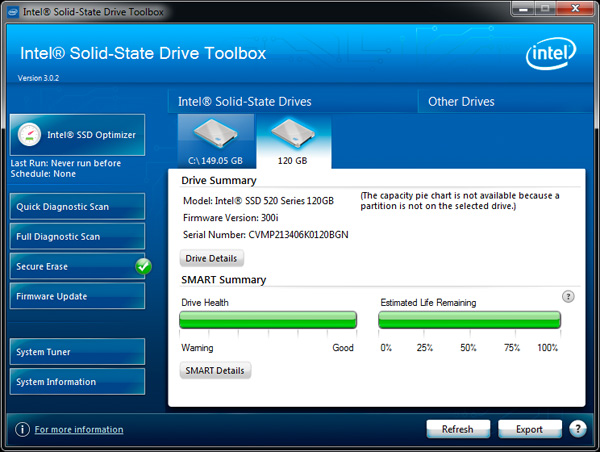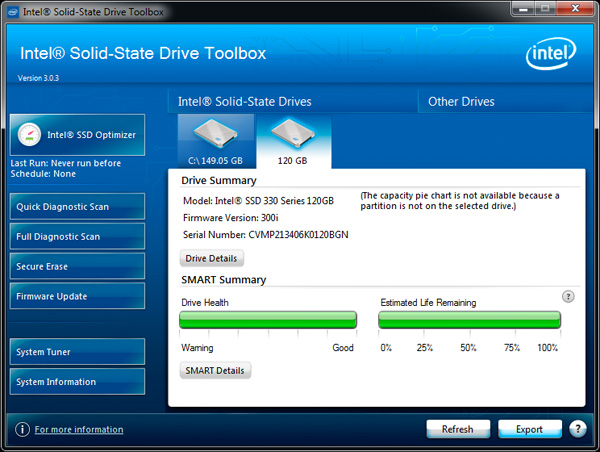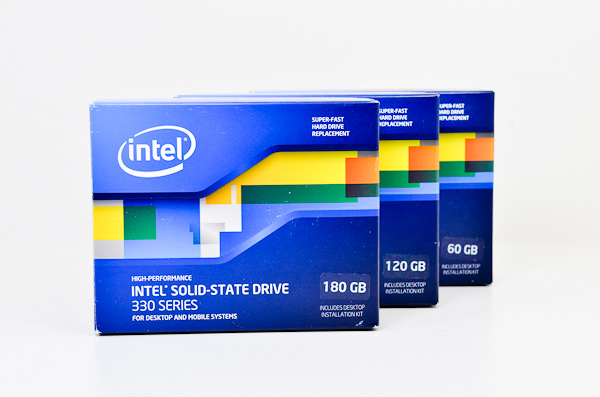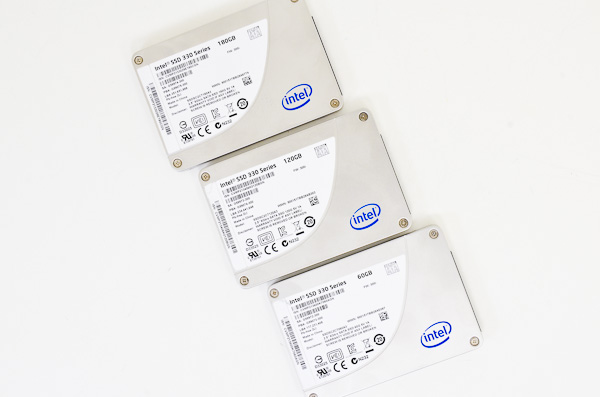The Intel SSD 330 Review (60GB, 120GB, 180GB)
by Anand Lal Shimpi on August 1, 2012 12:01 AM ESTEarlier this year Intel introduced its second SandForce based SSD: the Intel SSD 330. While Intel had previously reserved the 5xx line for 3rd party controllers, the 330 marks the first time Intel has used something other than its own branded controller in a mainstream or 3-series drive.
I don't doubt that I'll eventually get the story of how we got here. Apparently there's a good one behind why Intel's sequential write speed was capped at 100MB/s in the early days of the X25-M's controller. Regardless of how, this is where we are today: every new Intel SSD, with the exception of the high-end PCIe solution, is now powered by SandForce's SF-2281 controller and not Intel's own silicon.
The firmware is of course a collaboration between Intel and SandForce, although it's not clear if Intel ever had access to the firmware's source code or not. The result is a solution that performs a little differently than a standard SandForce drive, but should be less prone to compatibility/stability/reliability issues that have plagued SandForce drives for the past year. The latter is difficult to quantify.
We have seen examples of better behavior from Intel's SF-2281 firmware internally, and even wrote about one in our original Cherryville review. Despite Intel's best efforts, there are starting to be a small percentage of issues being reported in the wild. The number of publicly reported problems is very low, but it's impossible to say if this is a function of time or a truly superior design. I'm still comfortable in saying Intel's SandForce drives are good and likely better tested than any other SF drive, but as with any SSD, there can be issues depending on your system configuration. For what it's worth, even Intel's own controllers have had issues.
The Intel SSD 330
The 330 is available in four capacities: 60GB, 120GB, 180GB and 240GB. The limited launch capacities are a bit odd when you consider the Intel SSD 320 was available from 40GB all the way up to 600GB. Given the 330 uses the same controller as the 520, anyone who needs a larger drive can always buy the 520 instead.
Architecturally the 330 and 520 are identical. They both use the same SF-2281 6Gbps controller, and they both use Intel's 25nm MLC NAND. Actually, if you look at the 330's PCB itself you'll see the same layout as the 520 and Cherryville codename silkscreened onto the board. Despite the latter, Intel's SSD 330 is technically codenamed Maple Crest.
The similarities don't end there either. If you haven't updated to the latest Intel SSD Toolbox, the 330 is actually detected by the software as a 520:

Updating to the latest version rectifies the latter:

The 330 and 520 are very similar drives. The 330's primary differentiation comes from its use of cheaper, lower endurance MLC NAND. I'll get to the math behind why this isn't an issue at all for most users shortly. Conceptually, the 330 vs. the 520 is very similar to Kingston's HyperX 3K vs. regular HyperX drive. Just like with frequency binning for CPUs, there's endurance binning for NAND. Lower endurance parts are more plentiful (and thus cheaper) while the highest endurance parts will be sold for a premium (e.g. MLC-HET). If Intel does its job right, most of the stuff in the middle should be very good. And if it does its job really well, even the lower endurance parts should be more than good enough.
Intel's SSD 330 also carries a different firmware version from the 520: 300i vs. 400i. The firmware changes are likely minor in nature, however one major change is the loss of Intel's E2/E3/E4 SMART attributes for quick endurance testing. As I mentioned in our look at Intel SSDs in the enterprise, you can use these attributes to determine write amplification and estimate NAND longevity of a given workload. Intel views these as enterprise features, and with the 330's focus exclusively as a client drive it loses the features. You still have an accurate count of total host writes vs. NAND writes, as well as Intel's media wear indicator that lets you know what percentage of p/e cycles you have exhausted. I suspect this is more of Intel's famous forced segmentation at work rather than true delineation between client and datacenter drives. Depending on the server and workload, the 330 could be just fine.
Pricing
Using cheaper NAND allows Intel to be a little more aggressive on the 330's pricing without sacrificing margins. We turn to our Newegg pricing table once more to see where this puts the 330 in the grand scheme of things:
| SSD Price Comparison | |||||||
| Capacity | 60/64GB | 120/128GB | 180/192GB | 240/256GB | 480/512GB | ||
| Crucial m4 | $70 | $120 | $220 | $400 | |||
| Intel SSD 330 | $70 | $100 | $160 | ||||
| Intel SSD 520 | $90 | $125 | $190 | $255 | $500 | ||
| OCZ Vertex 3 | $70 | $95 | $200 | $530 | |||
| OCZ Vertex 4 | $75 | $115 | $210 | $550 | |||
| Plextor M3 | $160 | $270 | $575 | ||||
| Plextor M3 Pro | $180 | $280 | $680 | ||||
| Samsung SSD 830 | $128 | $143 | $282 | $700 | |||
Although SSD pricing is extremely volatile, Intel's SSD 330 tends to be among the cheaper solutions. The 60GB drive is just as cheap as the competition at $70, and the 120GB model is only $5 more than the chepaest alternative here. The 180GB drive is an interesting point below $200 if you need just a little more capacity than a 120GB drive would afford you. You pay a small price per GB penalty (~6%) but if you need capacity at a specific budget, it works. The newly announced 240GB drives were either backordered or not listed at many vendors.












64 Comments
View All Comments
Ryan Smith - Wednesday, August 1, 2012 - link
"I just wish Anand more honest by telling people the truth about SSD, specially SF based controller, because after trying more than 5 SF based SSD, I can say they're sucks! buy it only if you're planning to reformat your drive every now and then"So far every problem we've encountered with SF-2xxx has been documented, e.g. http://www.anandtech.com/show/5508/intel-ssd-520-r...
Beyond that we haven't encountered any additional SF-2xxx issues in our extended deployment testing. For example the 520 (330's sibling) is currently in one of my systems, having replaced a 120GB Vertex 2 that just recently passed 2 years of service.
amikey - Wednesday, August 1, 2012 - link
I have a 180GB SSD 330 in my 2009 Macbook Pro 13". It's totally fine, and running better than ever.Haven't enabled trim or updated the firmware since I got it (no pc to use) either.
I don't use disk encryption though, if you were to do that go with something else.
angelsmaster - Tuesday, September 4, 2012 - link
hi, you didn't update it or whatever? is it still up and running? and i think, its not trim supported when i checked it in the S-ATA system report, btw, i am using a macbook pro 15" 2011... thanks..quanstro - Wednesday, August 1, 2012 - link
how did you get this kind of experience with a just-released drive in a year-old computer?Jumpman23 - Wednesday, August 1, 2012 - link
In terms of cost and reliability the 330 seems like a good deal. What about in terms of performance and reliability? I've been hearing not so good things about the SF drives in general. The M4's and Samsung's 830 seems to get good reviews. So is there any particular drive that stands out as the best of the best?Per Hansson - Wednesday, August 1, 2012 - link
OCZ has a really poor track record when you look at RMA's:http://www.behardware.com/articles/862-7/component...
Weather this is due to the BSOD issue or other issue with their Sandforce drives I don't know.
But if you look at future data even OCZ's Petrol & Octane series has really bad RMA rates:
http://www.behardware.com/articles/862-8/component...
This makes me kind of weary of any Sandforce drive, we can see that since Intel has released Sandforce drives their failure rate has gone from 0.6% > 1.73% in the first link above.
This could be because of the "8MB bug" only but I am not convinced.
I would go for the Crucial M4 drive at this point, it has a great track record and only one known very specific problem (BSOD after 50k hours of ontime, caused by a bug in the SMART values & fixed by a firmware update)
Kristian Vättö - Wednesday, August 1, 2012 - link
The problem with those statistics is that they are extremely limited. Only four manufacturers are listed, and only OCZ's numbers are reported for individual models. The only info on sample size is that there must have been over 500 sales (brand) or 100 sales (model).I'm not defending OCZ or any other brand, just pointing out that a more thorough study would be needed to really know what SSDs are reliable. I do agree that Crucial's m4 is a great buy at the moment, and Samsung 830 and Plextor's SSDs are too.
lyeoh - Wednesday, August 1, 2012 - link
Only OCZ's numbers are reported for individual models becausequoting the article: "only OCZ has models with rates of above 5%".
You may need a more thorough study, but it's good enough for me to avoid OCZ.
Per Hansson - Wednesday, August 1, 2012 - link
Yea, it's a limited sample size but it's all we have to go on.We can also look at Newegg reviews, sure it has it's drawbacks aswell but when you see stuff like this it paints a quite clear picture I think:
128GB OCZ Petrol: http://www.newegg.com/Product/Product.aspx?Item=N8...
128GB OCZ Octane: http://www.newegg.com/Product/Product.aspx?Item=N8...
120GB OCZ RevoDrive 3: http://www.newegg.com/Product/Product.aspx?Item=20...
240GB OCZ Vertex 3: http://www.newegg.com/Product/Product.aspx?Item=N8...
128GB OCZ Vertex 4: http://www.newegg.com/Product/Product.aspx?Item=N8...
128GB Crucial M4: http://www.newegg.com/Product/Product.aspx?Item=N8...
antef - Wednesday, August 1, 2012 - link
I recommend the m4, it's been an amazing drive for me and the reviews on Newegg and Amazon are out of this world, the kind of thing you don't see very often. Don't fret over exact performance and worry that a newer drive might net you something slightly higher, all of these are crazy fast, my Windows machine with the m4 stays on the loading screen for all of 3 seconds, not even enough time to see the four colored orbs form together into the Windows logo.